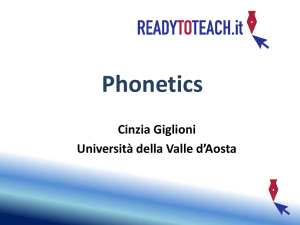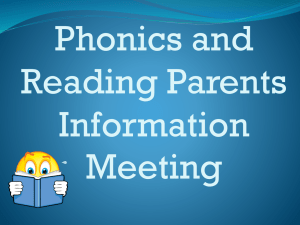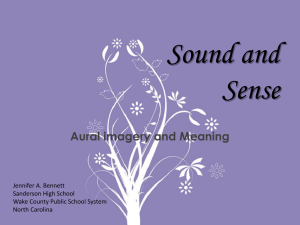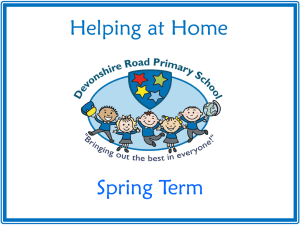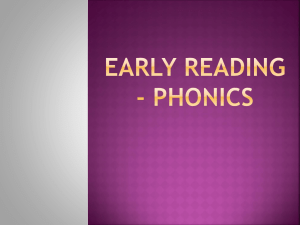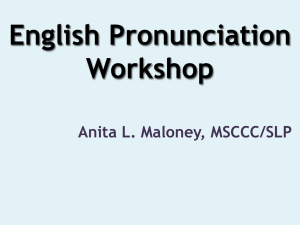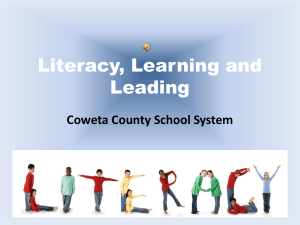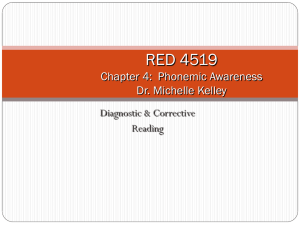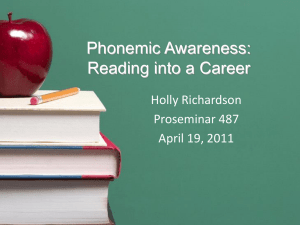Ch. 5 PP
advertisement
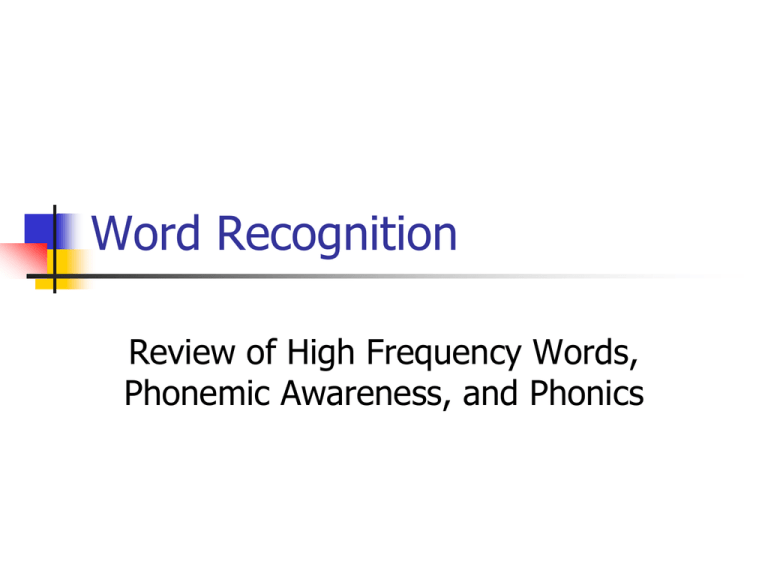
Word Recognition Review of High Frequency Words, Phonemic Awareness, and Phonics Stages in Reading Words Prealphabetic Usually around PK and K Environmental print Selective association Might use random letters to spell words May be able to spell their name bec/they have memorized the words. Stages in Reading Words Partial Alphabetic Letter-sound relationships used to read words. Words may be represented by using one letter. May begin to use vowels, but words will not be spelled correctly. Stages in Reading Words Full Alphabetic Sometimes also called letter-name stage. Begin to process all letters in words. Begin to apply their knowledge of lettersound relationships. Cautious reading word-by-word. Vowel sounds are spelled although it may not be correct. Stages in Reading Words Consolidated Alphabetic Sometimes called within-word pattern stage. Longer and more sophisticated words are processed. Begin to recognize words instantaneously on sight without having to analyze letter by letter. Word Recognition What is word recognition? Strategies we use to identify the oral equivalent of a word. What are areas included in word recognition? Sight Words Phonemic Awareness Structural Analysis Phonics Sight Words High Frequency Words Dolch Fry Colors Numbers How can we teach this type of word recognition area? Examples of centers—BINGO, Concentration, PIG, Cloze, Roll-Say-Keep, and Gameboards. Phonemic Awareness Awareness of Sounds in the Speech Stream Ways we can teach… How many sounds do you hear in cat, horse, and bath? Blending Segmenting Substituting—more advanced skill Lots of language play Rhymes Songs Examples of Phonemic Awareness— Rhyming Word Sit Down Children walk around the room in a big circle taking one step each time a rhyming word is said by the teacher. When the teacher says a word that does not rhyme with the other words, then the children sit down. Examples—she, tree, flea, spree, key, bee, sea, went (children sit down) Examples of Phonemic Awareness—Syllable Clap Talk with students about why knowing about syllables can help them read and write words. Ask students to clap with you to identify the syllables they hear in each word. Examples—adapt according to level of student airplane table porcupine school vacation dinner calendar television football Examples of Phonemic Awareness— Identification of Sounds in Words Using a song format to isolate the sound heard in the words—sung to Old McDonald. What’s the sound that starts these words—turtle and time and teeth? (Wait for response) /t/ is the sound that starts these words—turtle, time, and teeth. With a /t/, /t/ here, and /t/, /t/ there, here a /t/, there a /t/, everywhere a /t/, /t/. /t/ is the sound that starts these words—turtle and time and teeth. Repeat with also with middle sounds and ending sounds. Examples of Phonemic Awareness— Teaching Phonemic Blending—”I Say it Slowly, You Say it Fast” Game Explain to students that you will say the words slowly. Students should repeat the word back to you. Example— Teacher says /k/-/ă/-/t/ Child says cat. Example— Teacher says /r/-/ŏ/-/k/ Child says rock. Examples of Phonemic Awareness—Sound boxes Show students how to make sound boxes on their paper or lap boards. As the student says a word, then she stretches it out, while sliding a marker into each box as the sound, or phoneme, is heard. Example— dog horse Lamp teeth Examples of Phonemic Awareness— Phonemic Segmentation This activity teaches phonemic segmentation using a song format—Twinkle, Twinkle, Little Star (sort of) Listen, listen to my word, Then tell me all the sounds you heard race /r/ is one sound /ā/ is two /s/ is last in race, it’s true. Thanks for listening to my word, And telling all the sounds you heard. Examples of Phonemic Awareness— Consonant Substitution The most difficult task to do—substitution— requires multiple levels of processing. Children listen to a given word, then substitute a new sound in the word. Example— What What What What rhymes rhymes rhymes rhymes with with with with pig and starts with /d/--dig. book and starts with /k/--cook. sing and starts with /r/--ring. dog and starts with /fr/--frog. Structural Analysis Looking at parts of the words, or chunks. Knowledge of syllables. Includes compound words, contractions, multisyllable words, inflectional endings, prefixes, suffixes. Teach by analogy by focusing on onset and rime: Onset—part of the syllable prior to the vowel Rime—vowel to the end of the syllable Example—cat– “c” is onset, “-at” is rime If I can spell cat, then I can spell bat, fat, hat, mat, pat, rat, sat, and vat. Example—hit—”h” is onset, “-it” is rime If I can spell hit, then I can spell bit, fit, kit, lit, sit, wit, and zit. Implications for Instruction in Syllabic Analysis Ss should be taught to process all of the syllables in words. Ss need to be taught to see patterns in words. Ss need to be flexible in their decoding of words-they should be prepared to try another pronunciation if one way does not work. Ss should integrate context and syllabic analysis. Ss need to be reminded to use orthographic aspects of phonics (awareness of sequence of letters when spelling the word). Ss should be aware that an element in a multisyllabic word may not be read in the same way as it is represented in a single syllable word (carrots, car). Elements such as –tion and –ture as in mention and future, which only occur in multisyllabic words, need a careful introduction, frequent review, and a great deal of practice. Generalization Approach to Teaching Syllabic Analysis Ask students to sort a group of words. Teach a generalization (general rule) for dividing words, such as: Easy affixes-most form a separate syllable (ex. help-ful, re-build) Compound words-usually are two separate words (ex. sun-set, night-fall) Two consonants between two vowels-usually divide between the two consonants (ex. win-ter, con-cept) The ending –le-usually combined with a preceding consonant to create a separate syllable (ex. cra-dle, ma-ple) Two vowels together-a limited number of words split between the two vowels (ex. i-de-a, di-al). The idea behind teaching Ss an awareness of syllabic analysis is that it helps students to decode an unfamiliar by separating the word into its syllabic parts, then recombining the parts into a whole. Pattern Approach to Syllabic Analysis Introduce the syllabic pattern-introduce the pattern in a single syllable word Present the pattern along with a model word Formulate a generalization. Guided Practice Application Assessment and Review Extension Multisyllabic Patterns In order of difficulty: Easy affixes: play-ing Compound words: base-ball Closed syllable words: rab-bit Open syllable words: ba-by Final –e markers: es-cape Vowel digraphs: a-gree Other patterns: cir-cle See also pp. 250-252 for major syllable patterns. Finally, we get to Phonics! Phonics, graphophonics, graphophonemics—all the same thing. Breakdown— How does this differ from phonemic awareness? Graph—means written Phonic—means sound Study of letter-sound relationships If you know that there are 3 sounds in cat, then you are phonemically aware. If you know that the first sound /k/ is made by the letter “c”, then that is phonics. Phonics is all about teaching the code—how students can break down words to figure out how to say the word or how to spell the word. Key Terms to Remember Phoneme Individual speech sounds How many phonemes are in bath? (3) Grapheme Refers to the letter that corresponds to a specific phoneme What graphemes represent the phonemes you heard in bath-- /b/, /ă/, /th/. Key Terms to Remember Morpheme Smallest unit of meaning--could be a word, a prefix, a suffix, or a root. How many morphemes are in these words? Unladylike un- 'not' lady '(well behaved) female adult human' like 'having the characteristics of' Dogs Dog- animal s-plural marker on nouns Technique One morpheme—technique consists of only one meaningful word part, however it does have two syllables. Basic Principles of Phonics Instruction Must be Functional Must be Useful It must teach skills necessary for decoding words. The skills should be ones that students do not already know. Must be Contextual The skills being taught should be related to reading tasks in which students are currently engaged or will soon be engaged. Consonants There are 25 sounds in English. Some are spelled with two letters that represent one sound. Digraph—ch, sh, th Some are groups of consonants that represent two or three letter sounds. Clusters—most are composed of l, r, or s with another consonant sound. Vowels There are 16 vowels sounds in the English language. This number can vary by dialect. Types of vowel sounds: Short vowel sounds--/a/, /e/, /i/, /o/, /u/ Long vowel sounds--/ā/, /ē/, /ī/, /ō/, /ū/ More Vowel Sounds Other vowel sounds— /aw/--daughter, law, walk /oi/--noise, toy /ŏŏ/--wood, should, push / ōō/--soon, new, prove, group /ow/--tower, south /∂/--above, operation, similar R-controlled vowel sounds— /ar/--far /air/--hair /i(∂)r/--steer, clear, here /∂r/--her, sir, fur /or/--horse, door, tour Onset and Rimes Onset-the consonant or consonant cluster preceding the rime Rime-vowel, vowels, or consonants that follow the onset Cat C-onset At-rime That Th-onset At-rime Refer to pp. 216-218 for a list of major word patterns that can be taught using the idea of onset and rime. Scope and Sequence Consonants usually presented first. Fewer spelling options for consonants. Initial letters, which are usually consonants, are best taught first. Skills taught in one grade are usually addressed again in another grade. Use major word patterns. Using decodable texts. Look at S&S on page 214. Teaching Initial Consonants Phonics instruction usually begins with initial consonants. Being the first sound in a word makes it easier for students to hear.. Beginning sounds are also usually the first sound to appear in students’ invented spelling. Begin phonics lesson with emphasis on phonemic awareness. Teaching Final Consonants Handle the teaching of final consonants in the same way as initial consonants. Final consonants are significant aid in the decoding of printed words, so be sure to not neglect them. You can teach the final sound as you also teach word patterns that use them. /d/ in -ad Teaching Consonant Clusters Sometimes called blends Combination of consonants sp- in spot str- in straw It can be difficult for students to separate the sounds (especially for “l” and “r” clusters. Begin with “s” clusters. Introduce a word with the cluster, then also a word with one part of the cluster missing (ex. stick-sick; stand-sand; stink, sink). Ask students what the second word is missing that was present in the first word. Slowly say the word and have students count the sounds (ex. stick). Teaching Vowel Correspondences Vowels can be taught in the same way as consonants. The main difference is that the vowels can be spoken in isolation without distorting the sound. Vowels can be taught in isolation or as part of patterns. Approaches to Teaching Phonics Analytic Studying sounds within the context of the whole word. Example--/w/ is the sound heard at the beginning of the word wagon. Synthetic Saying a word sound by sound then synthesizing the sounds into words. Example--/k/ /a/ /t/ equals cat. Analytic Phonics—Steps Analytic Phonics provides students with opportunities to analyze whole words and break the words down into smaller, manageable parts. Identify a list of words that share a common letter-sound relationship. Say each word aloud to students and pause to let students repeat the word back. Move through each word in the list. Ask students what they notice about the words, such as how the words look or sound alike or different. Through this discussion, lead students into a recognition of the common letter-sound relationship. Help students to identify a generalization about the letter-sound relationship. Synthetic Phonics—Steps Synthetic phonics first teaches students letter/sounds, then students practice blending the sounds together to make words. Introduce each letter name to students. Teach the sound that each letter makes. As each letter is written on the board or chart paper then point to the letter, and say the sound that each letter makes. Make a hand motion to indicate blending the sounds together. Continue this process until students can easily recognize the letter and the corresponding sound. Steps for TeachingAnalytic/Synthetic Combination Phonemic awareness-introduce sound (ex. /m/, talk about position of mouth when forming the sound (lips are pressed together), call attention to words in a poem or other text that have that sound Letter-sound integration-write the words with that sound on the board-ex. man, moon, milk; discuss with students that these words all have the /m/ sound that is represented by the letter “m” Guided practice-read a story that has this sound, sing a song, read or poem, and/or compose sentences Application-students read selections that contain that sound Writing and spelling-review the formation of the letter “m”, dictate some easy words with this letter/sound. Assessment and reteaching-note whether students are able to apply their knowledge of “m” while reading or writing, review and reteach as necessary Examples of Centers This next section provides examples of different centers as each is related to a stage of reading. Emergent Stage Age Level Reading Words Usually around prekindergarten or kindergarten. Do not understand that letters in written words have sounds. Limited to reading words from memory—sight word reading. Guess words from context. Will pretend to read text. Writing Words Scribbles, letter-like forms, or random letters that probably do not correspond to a matching letter-sound relationship. Corresponding WTW Spelling Stage: Emergent Developing Fluency Fluency—the ability to read text accurately and quickly. Two components: Repeated Readings Automaticity—recognize words rapidly Accuracy—being able to identify the word Shared Reading Guided Reading Choral Readings Read Aloud Example of Phonics Centers Emergent Stage BINGO BRS Sort PTM Sort Follow the Path Game—BRSPTM CFD Sort 3-Cat Sort 5-Cat Sort From WTW Spelling Stage: Emergent Stage Beginning Stage Age Level Usually begins around kindergarten or first grade. Reading Words Begin to detect letters in words to some of the sounds they correspond to. May use partial letter cues to identify unfamiliar words. May misread words with similar letters—man for men, this for that, horse for house. May sometimes read words backward as they learn directionality—was for saw. Sight word vocabulary continues to grow. Learn the sounds that correspond to basic consonants—b, d, f, j, k, l, m, n, p, r, s, t, v, z—but not soft sounds of c (/s/) and g (/j/) or hard sounds of c (/k/) and g (/g/). Will finger-point (point to words as they are read) and read aloud slowly word by word. Beginning Stage Continued Writing Words Beginning and ending sounds will be represented. Letter names used to spell vowel sounds. Begin to spell phonetically. Most silent letters are omitted. Corresponding WTW Spelling Stage: Letter NameAlphabetic Stage Examples of Phonics Centers Beginning Stage LRS sort—l-blends, r-blends, s-blends ch and th sort—digraphs ch and sh Shopping Game—ch and sh Gruff Drops Troll at the Bridge—r-blend words Corresponding WTW Spelling Stage: Letter Name-Alphabetic Stage Transitional Stage Age Level Reading Words Usually around Second Grade and can continue through Fourth Grade. Begin to learn chunks of words, such as onset, rime, syllables, affixes, and root words, and how these chunks occur in different words. Begin to recognize spelling patterns that occur frequently in words: -it, -at, -in, -an, -and, -all. Sight word vocabulary continues to grow as they begin to store longer words in their memory. Reading words by analogy becomes easier as they begin to recognize spelling patterns in words. Children begin to read with more expression as they develop fluency and ease with reading. Writing Words Practice dividing written words into onset-rime. Practice reading and spelling words by analogy. Corresponding WTW Spelling Stage: Within Word Pattern Stage Examples of Phonics Centers Transitional Stage Flip-It—long and short vowel patterns, featuring CVCe Treasure—r-controlled vowel patterns Turkey Feathers—long vowel sound patterns Corresponding WTW Spelling Stage: Within Word Pattern Stage Intermediate Level Age Level Reading Also can begin around Second, Third, or Fourth Grade and can continue through eighth grade. Focus at this level is on broader elements of words represented by syllables. Continue to develop fluency and read with expression. Preferred way of reading is probably silent versus oral. May begin to experiment with different types of genres in reading, as they explore which one they like the best. Writing Look at words that represent more complex phonic generalizations, such as adding inflectional endings, prefixes/suffixes, and how and when to do consonant doubling. Help explore vocabulary words by looking at relationships between words. Corresponding WTW Spelling Stage: Syllables and Affixes Stage Examples of Phonics Centers Intermediate Stage Freddy, the Hopping, Diving, Jumping Frog—double, do nothing, drop the –e The Apple and the Bushel—differentiate between –el and –le endings Homograph Concentration—using context Corresponding WTW Spelling Stage: Syllables and Affixes Stage Advanced Stage Age Level Can begin around fifth grade and continue into high school. Reading Words Readers have highly developed automaticity and speed in reading familiar and unfamiliar words. Most words they read are already in their sight word vocabulary. Readers have multiple strategies they can use when they come across a word they do not know. Recognition of words is so automatic that the major focus shifts to finding meaning from text. Writing Words Look at words with prefixes and suffixes that are not as common in words, and explore how to know word meaning based on the prefix, suffix, or context the word is used. Explore etymology of words. Examples of Phonics Centers with Vocabulary Connection Advanced Stage—also known as Derivational Relations Word Sort— -tion or -sion Word Trees Jeopardy Semantic Feature Analysis Combining roots and affixes Corresponding WTW Spelling Stage: Derivational Relations Stage
